child lock DODGE RAM 3500 DIESEL 2008 3.G Owners Manual
[x] Cancel search | Manufacturer: DODGE, Model Year: 2008, Model line: RAM 3500 DIESEL, Model: DODGE RAM 3500 DIESEL 2008 3.GPages: 527, PDF Size: 8.88 MB
Page 12 of 527
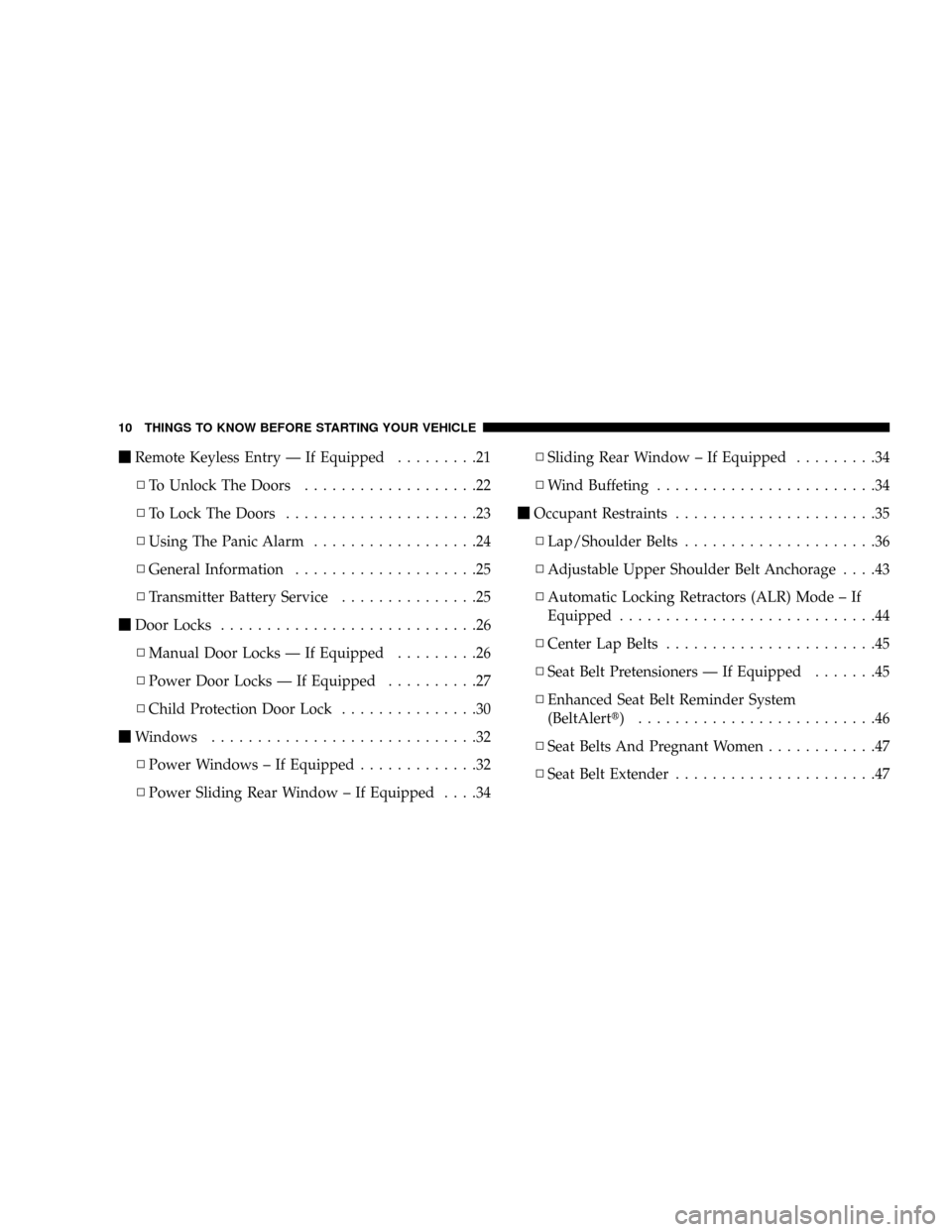
mRemote Keyless Entry Ð If Equipped.........21
NTo Unlock The Doors...................22
NTo Lock The Doors.....................23
NUsing The Panic Alarm..................24
NGeneral Information....................25
NTransmitter Battery Service...............25
mDoor Locks............................26
NManual Door Locks Ð If Equipped.........26
NPower Door Locks Ð If Equipped..........27
NChild Protection Door Lock...............30
mWindows.............................32
NPower Windows ± If Equipped.............32
NPower Sliding Rear Window ± If Equipped....34NSliding Rear Window ± If Equipped.........34
NWind Buffeting........................34
mOccupant Restraints......................35
NLap/Shoulder Belts.....................36
NAdjustable Upper Shoulder Belt Anchorage....43
NAutomatic Locking Retractors (ALR) Mode ± If
Equipped............................44
NCenter Lap Belts.......................45
NSeat Belt Pretensioners Ð If Equipped.......45
NEnhanced Seat Belt Reminder System
(BeltAlertt) ..........................46
NSeat Belts And Pregnant Women............47
NSeat Belt Extender......................47
10 THINGS TO KNOW BEFORE STARTING YOUR VEHICLE
Page 13 of 527
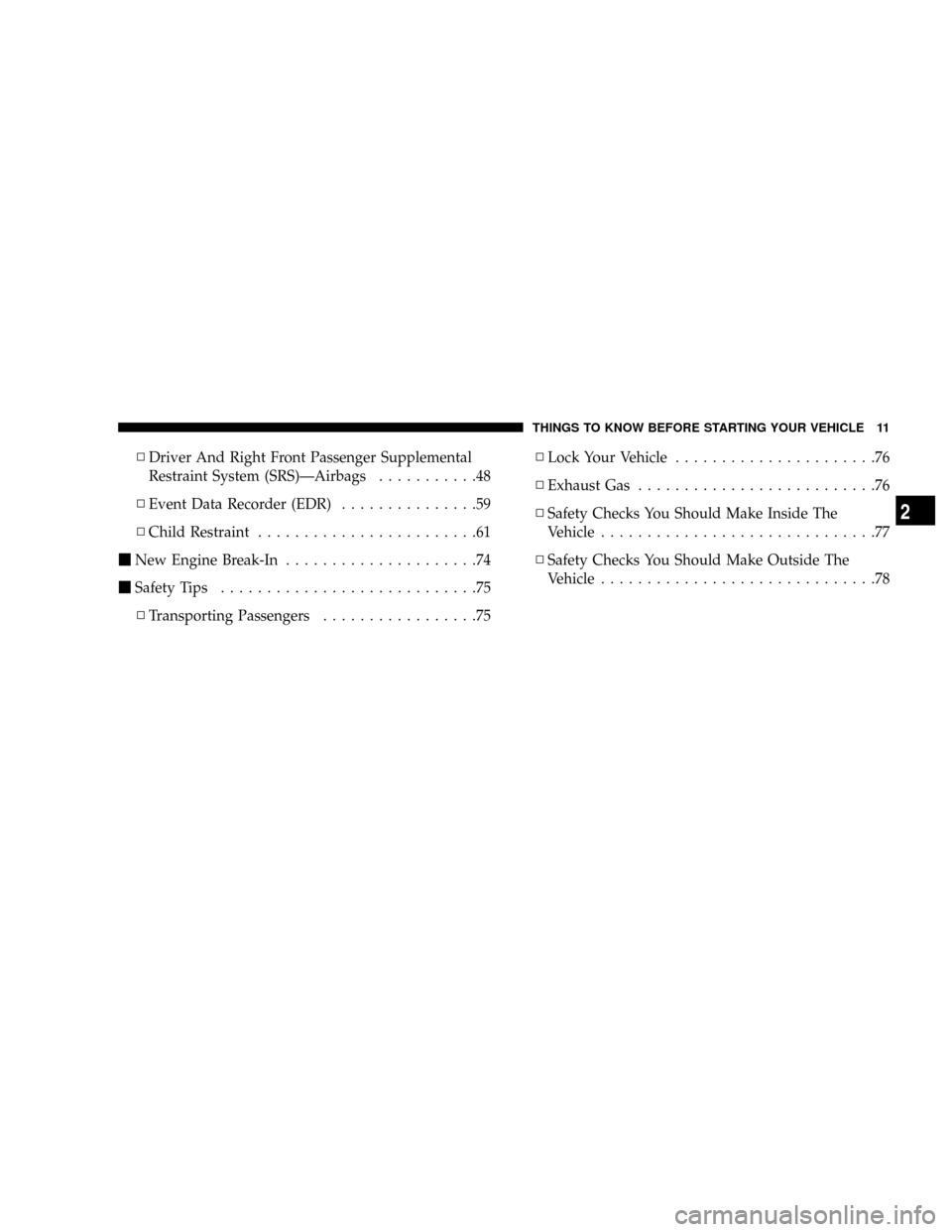
NDriver And Right Front Passenger Supplemental
Restraint System (SRS)ÐAirbags...........48
NEvent Data Recorder (EDR)...............59
NChild Restraint........................61
mNew Engine Break-In.....................74
mSafety Tips............................75
NTransporting Passengers.................75NLock Your Vehicle......................76
NExhaust Gas..........................76
NSafety Checks You Should Make Inside The
Vehicle..............................77
NSafety Checks You Should Make Outside The
Vehicle..............................78
THINGS TO KNOW BEFORE STARTING YOUR VEHICLE 11
2
Page 29 of 527
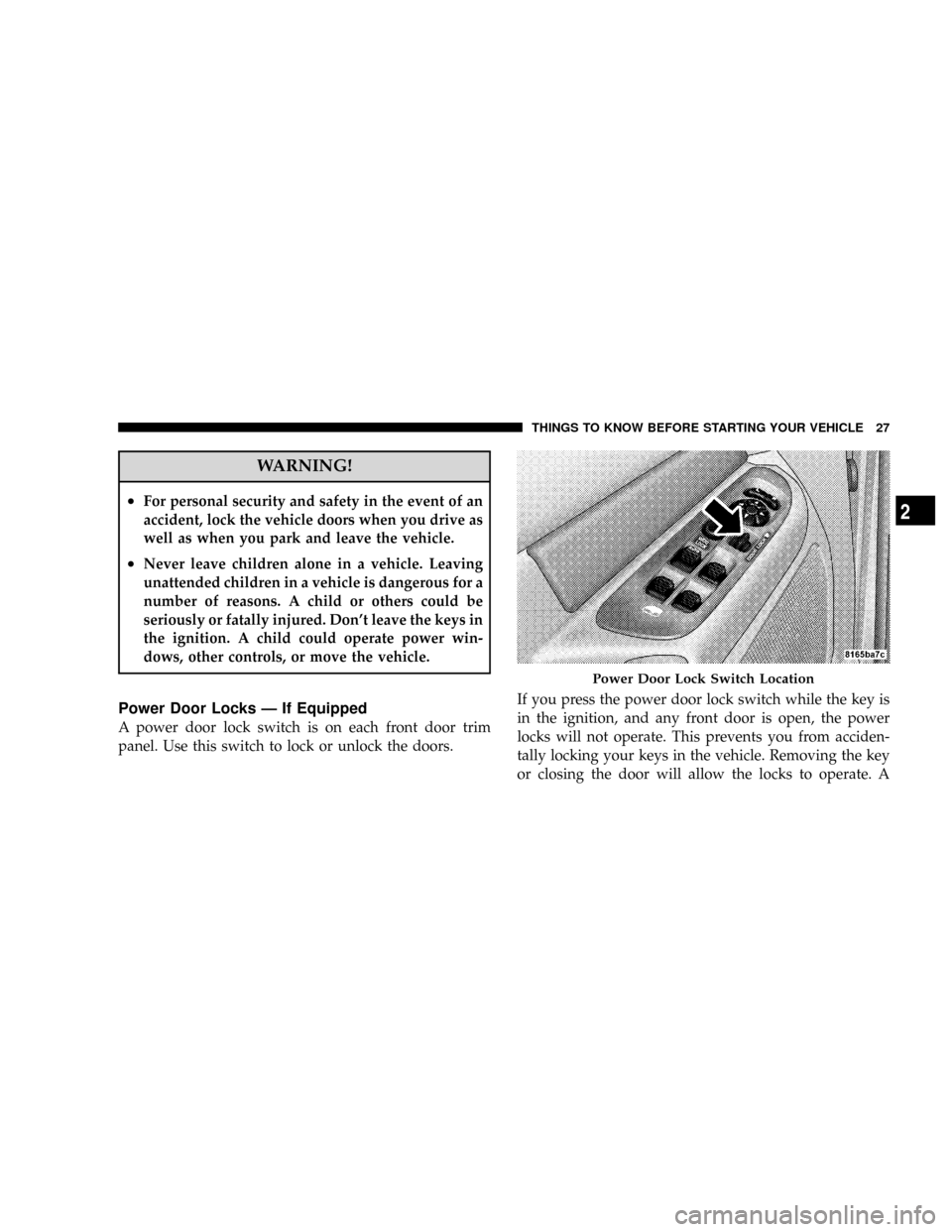
WARNING!
²For personal security and safety in the event of an
accident, lock the vehicle doors when you drive as
well as when you park and leave the vehicle.
²Never leave children alone in a vehicle. Leaving
unattended children in a vehicle is dangerous for a
number of reasons. A child or others could be
seriously or fatally injured. Don't leave the keys in
the ignition. A child could operate power win-
dows, other controls, or move the vehicle.
Power Door Locks Ð If Equipped
A power door lock switch is on each front door trim
panel. Use this switch to lock or unlock the doors.If you press the power door lock switch while the key is
in the ignition, and any front door is open, the power
locks will not operate. This prevents you from acciden-
tally locking your keys in the vehicle. Removing the key
or closing the door will allow the locks to operate. A
Power Door Lock Switch Location
THINGS TO KNOW BEFORE STARTING YOUR VEHICLE 27
2
Page 32 of 527
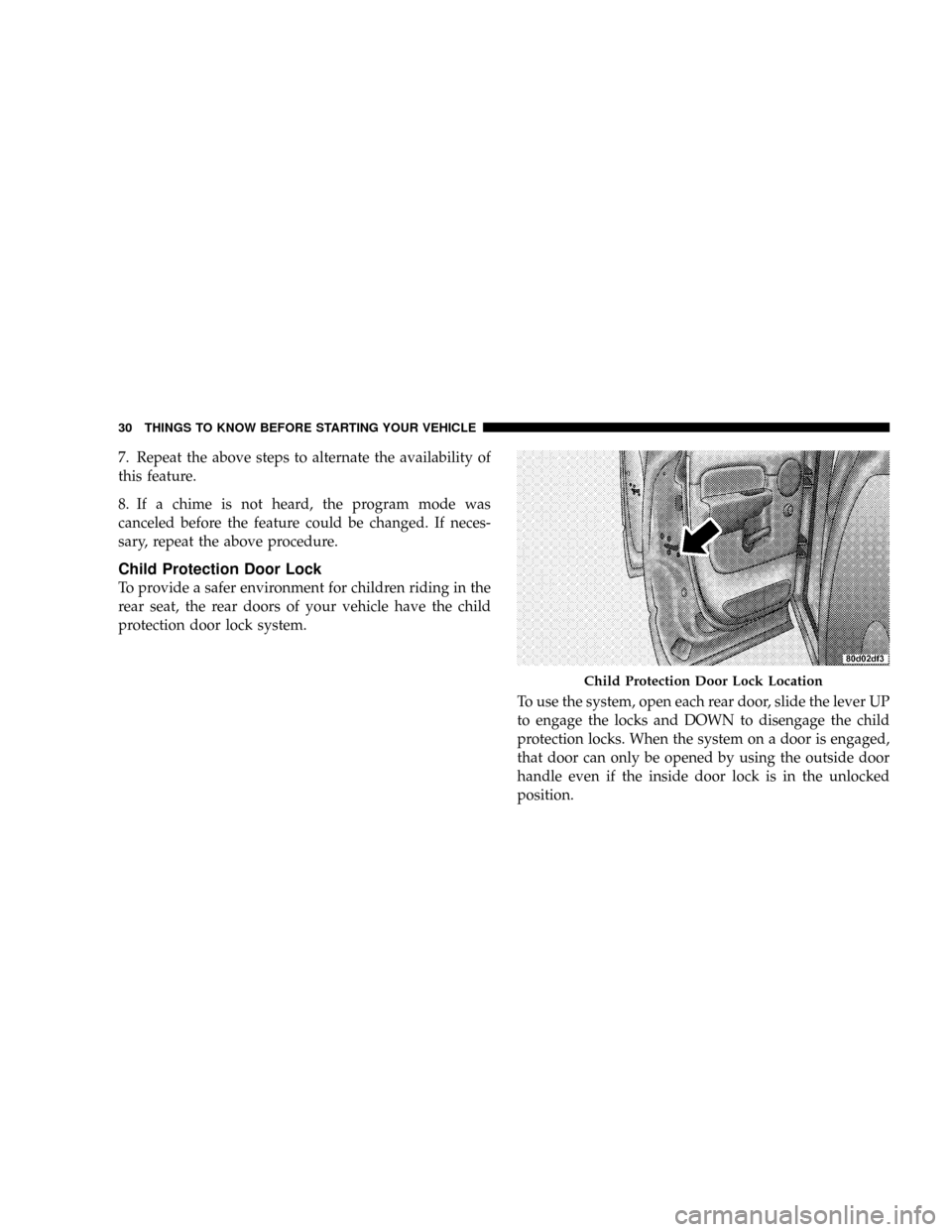
7. Repeat the above steps to alternate the availability of
this feature.
8. If a chime is not heard, the program mode was
canceled before the feature could be changed. If neces-
sary, repeat the above procedure.
Child Protection Door Lock
To provide a safer environment for children riding in the
rear seat, the rear doors of your vehicle have the child
protection door lock system.
To use the system, open each rear door, slide the lever UP
to engage the locks and DOWN to disengage the child
protection locks. When the system on a door is engaged,
that door can only be opened by using the outside door
handle even if the inside door lock is in the unlocked
position.
Child Protection Door Lock Location
30 THINGS TO KNOW BEFORE STARTING YOUR VEHICLE
Page 33 of 527
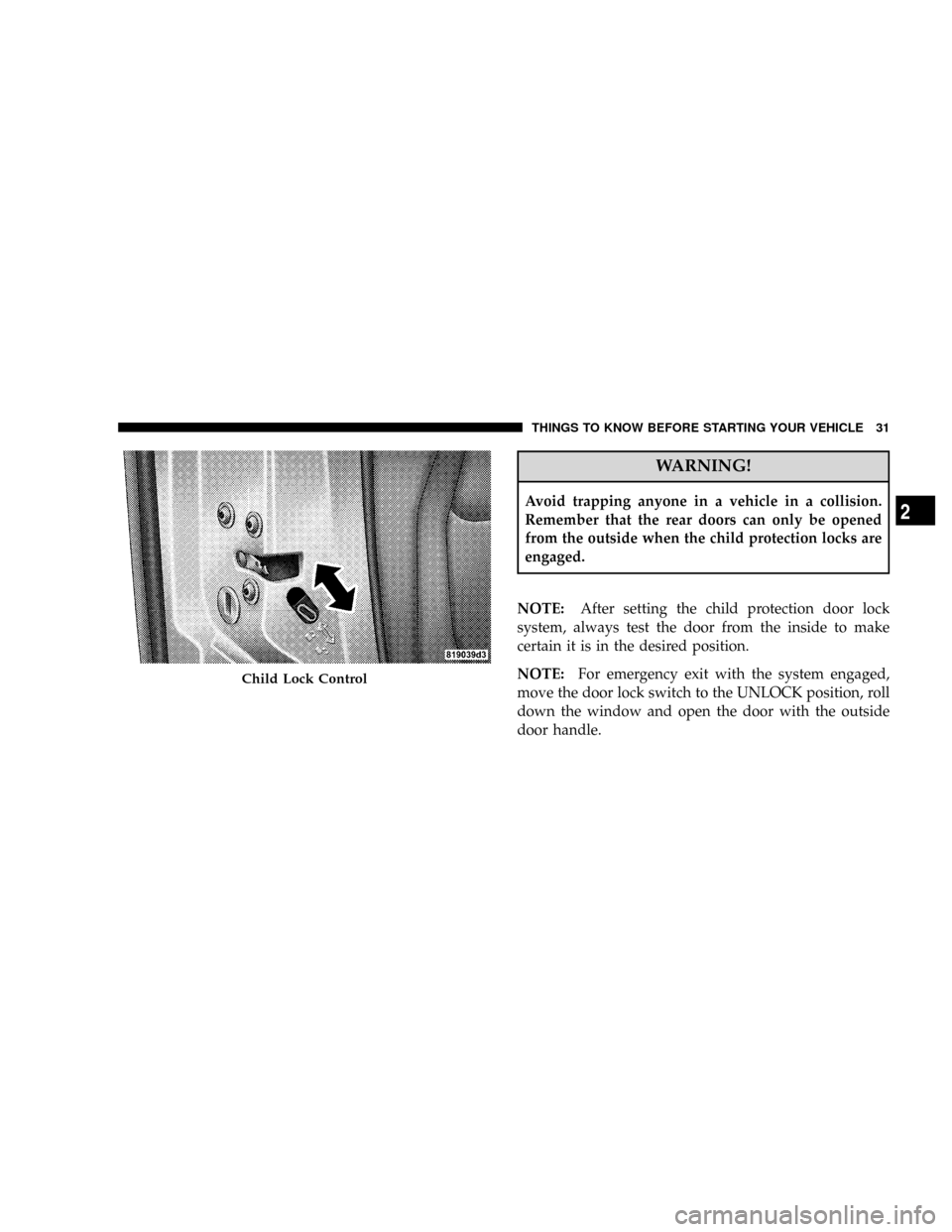
WARNING!
Avoid trapping anyone in a vehicle in a collision.
Remember that the rear doors can only be opened
from the outside when the child protection locks are
engaged.
NOTE:After setting the child protection door lock
system, always test the door from the inside to make
certain it is in the desired position.
NOTE:For emergency exit with the system engaged,
move the door lock switch to the UNLOCK position, roll
down the window and open the door with the outside
door handle.
Child Lock Control
THINGS TO KNOW BEFORE STARTING YOUR VEHICLE 31
2
Page 46 of 527
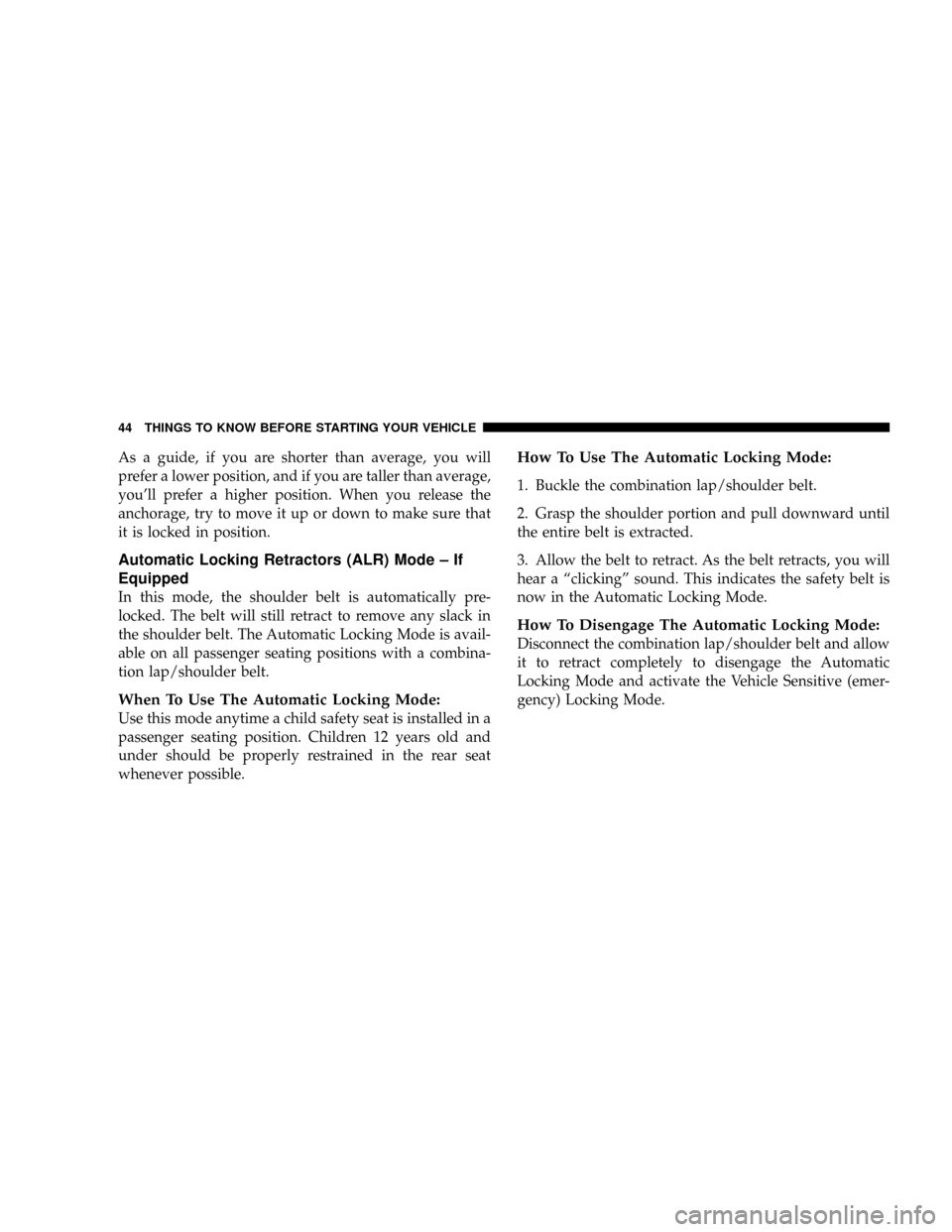
As a guide, if you are shorter than average, you will
prefer a lower position, and if you are taller than average,
you'll prefer a higher position. When you release the
anchorage, try to move it up or down to make sure that
it is locked in position.
Automatic Locking Retractors (ALR) Mode ± If
Equipped
In this mode, the shoulder belt is automatically pre-
locked. The belt will still retract to remove any slack in
the shoulder belt. The Automatic Locking Mode is avail-
able on all passenger seating positions with a combina-
tion lap/shoulder belt.
When To Use The Automatic Locking Mode:
Use this mode anytime a child safety seat is installed in a
passenger seating position. Children 12 years old and
under should be properly restrained in the rear seat
whenever possible.
How To Use The Automatic Locking Mode:
1. Buckle the combination lap/shoulder belt.
2. Grasp the shoulder portion and pull downward until
the entire belt is extracted.
3. Allow the belt to retract. As the belt retracts, you will
hear a ªclickingº sound. This indicates the safety belt is
now in the Automatic Locking Mode.
How To Disengage The Automatic Locking Mode:
Disconnect the combination lap/shoulder belt and allow
it to retract completely to disengage the Automatic
Locking Mode and activate the Vehicle Sensitive (emer-
gency) Locking Mode.
44 THINGS TO KNOW BEFORE STARTING YOUR VEHICLE
Page 66 of 527
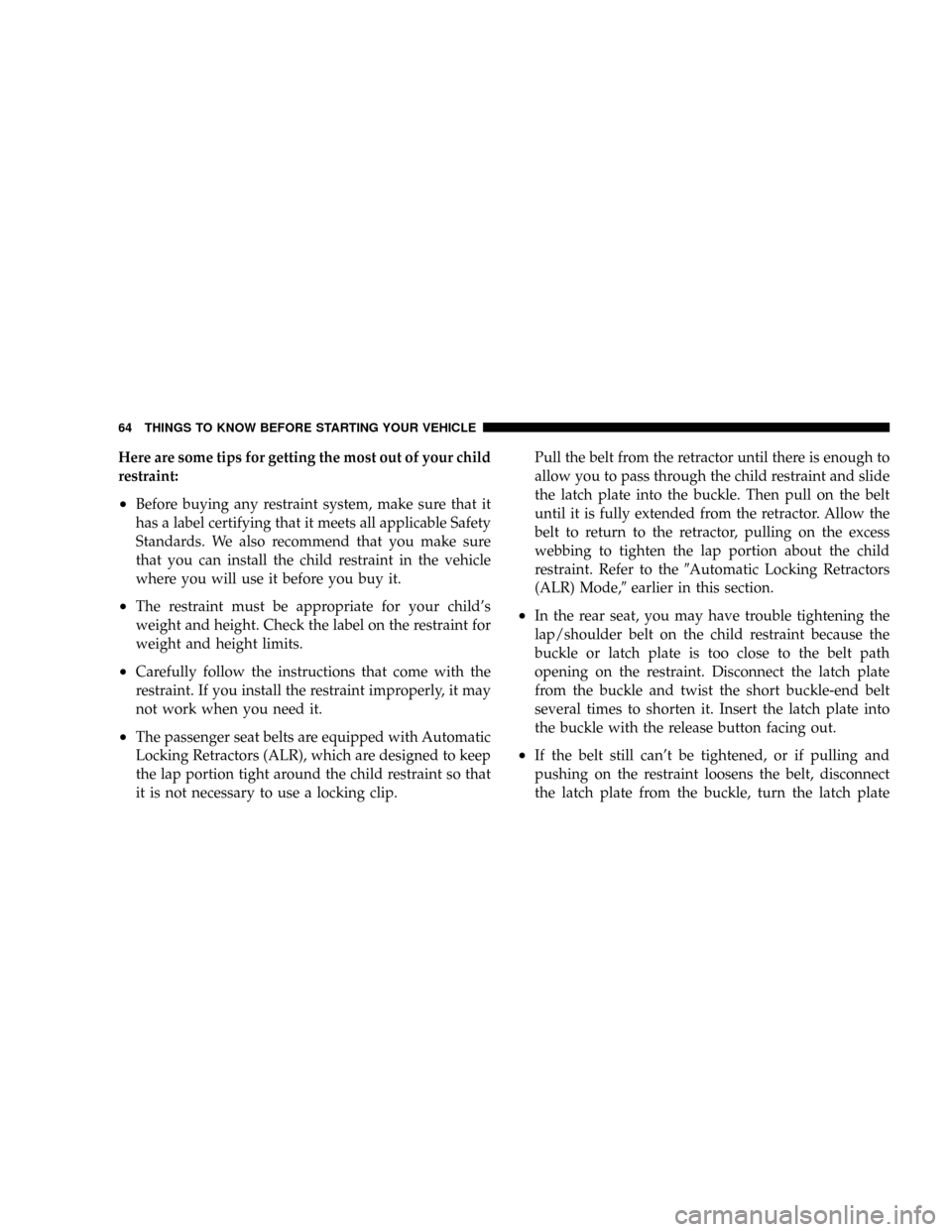
Here are some tips for getting the most out of your child
restraint:
²Before buying any restraint system, make sure that it
has a label certifying that it meets all applicable Safety
Standards. We also recommend that you make sure
that you can install the child restraint in the vehicle
where you will use it before you buy it.
²The restraint must be appropriate for your child's
weight and height. Check the label on the restraint for
weight and height limits.
²Carefully follow the instructions that come with the
restraint. If you install the restraint improperly, it may
not work when you need it.
²The passenger seat belts are equipped with Automatic
Locking Retractors (ALR), which are designed to keep
the lap portion tight around the child restraint so that
it is not necessary to use a locking clip.Pull the belt from the retractor until there is enough to
allow you to pass through the child restraint and slide
the latch plate into the buckle. Then pull on the belt
until it is fully extended from the retractor. Allow the
belt to return to the retractor, pulling on the excess
webbing to tighten the lap portion about the child
restraint. Refer to the9Automatic Locking Retractors
(ALR) Mode,9earlier in this section.
²In the rear seat, you may have trouble tightening the
lap/shoulder belt on the child restraint because the
buckle or latch plate is too close to the belt path
opening on the restraint. Disconnect the latch plate
from the buckle and twist the short buckle-end belt
several times to shorten it. Insert the latch plate into
the buckle with the release button facing out.
²If the belt still can't be tightened, or if pulling and
pushing on the restraint loosens the belt, disconnect
the latch plate from the buckle, turn the latch plate
64 THINGS TO KNOW BEFORE STARTING YOUR VEHICLE
Page 127 of 527
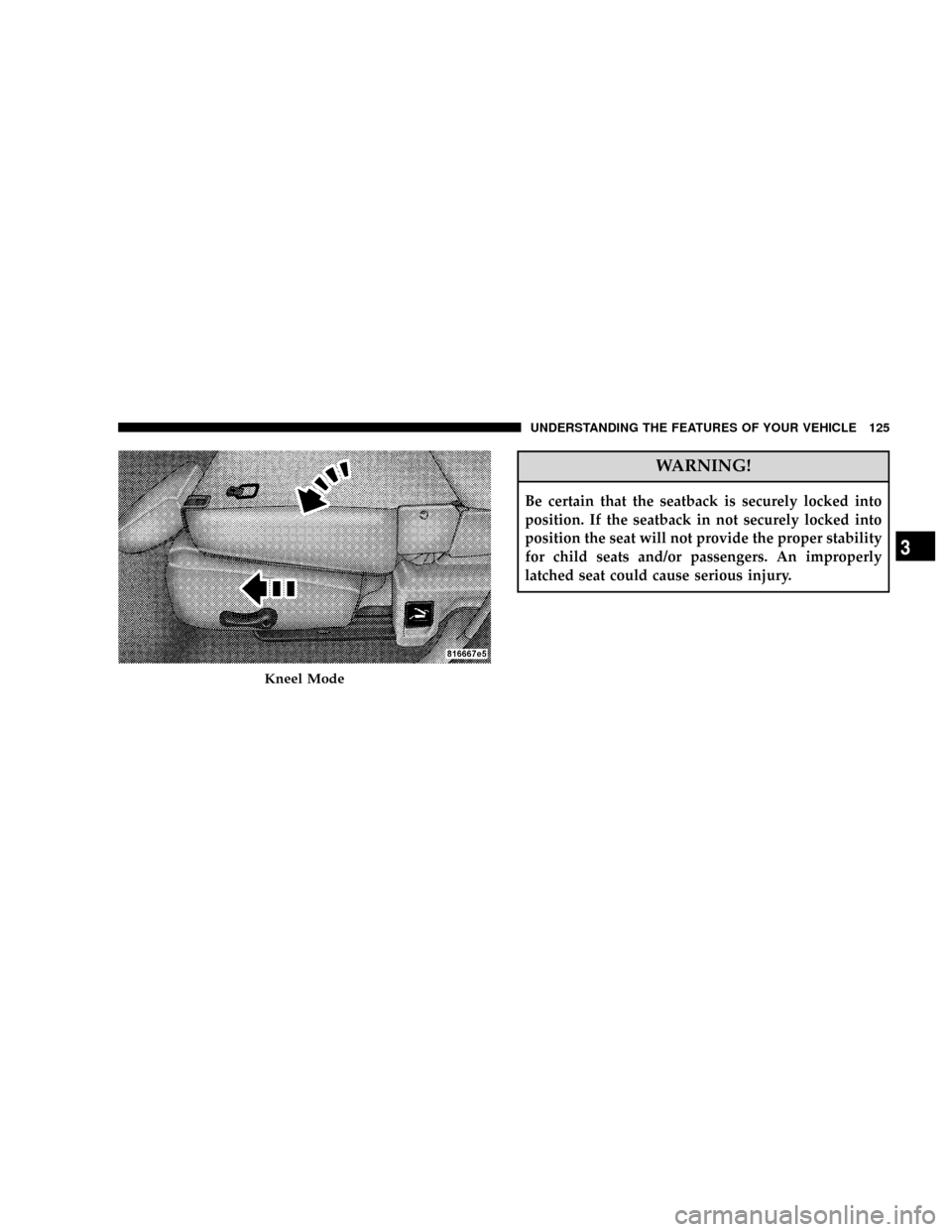
WARNING!
Be certain that the seatback is securely locked into
position. If the seatback in not securely locked into
position the seat will not provide the proper stability
for child seats and/or passengers. An improperly
latched seat could cause serious injury.
Kneel Mode
UNDERSTANDING THE FEATURES OF YOUR VEHICLE 125
3
Page 270 of 527
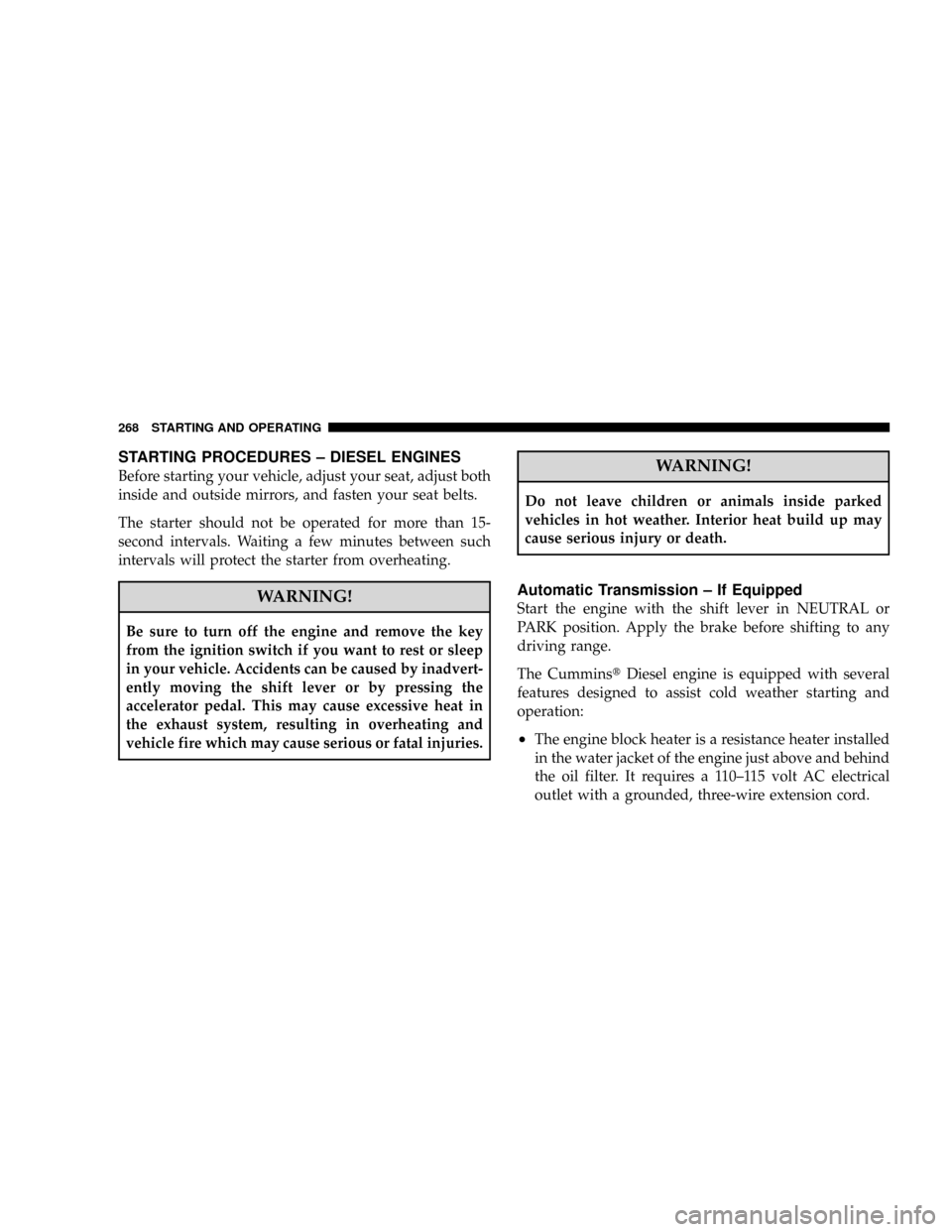
STARTING PROCEDURES ± DIESEL ENGINES
Before starting your vehicle, adjust your seat, adjust both
inside and outside mirrors, and fasten your seat belts.
The starter should not be operated for more than 15-
second intervals. Waiting a few minutes between such
intervals will protect the starter from overheating.
WARNING!
Be sure to turn off the engine and remove the key
from the ignition switch if you want to rest or sleep
in your vehicle. Accidents can be caused by inadvert-
ently moving the shift lever or by pressing the
accelerator pedal. This may cause excessive heat in
the exhaust system, resulting in overheating and
vehicle fire which may cause serious or fatal injuries.
WARNING!
Do not leave children or animals inside parked
vehicles in hot weather. Interior heat build up may
cause serious injury or death.
Automatic Transmission ± If Equipped
Start the engine with the shift lever in NEUTRAL or
PARK position. Apply the brake before shifting to any
driving range.
The CumminstDiesel engine is equipped with several
features designed to assist cold weather starting and
operation:
²The engine block heater is a resistance heater installed
in the water jacket of the engine just above and behind
the oil filter. It requires a 110±115 volt AC electrical
outlet with a grounded, three-wire extension cord.
268 STARTING AND OPERATING
Page 313 of 527
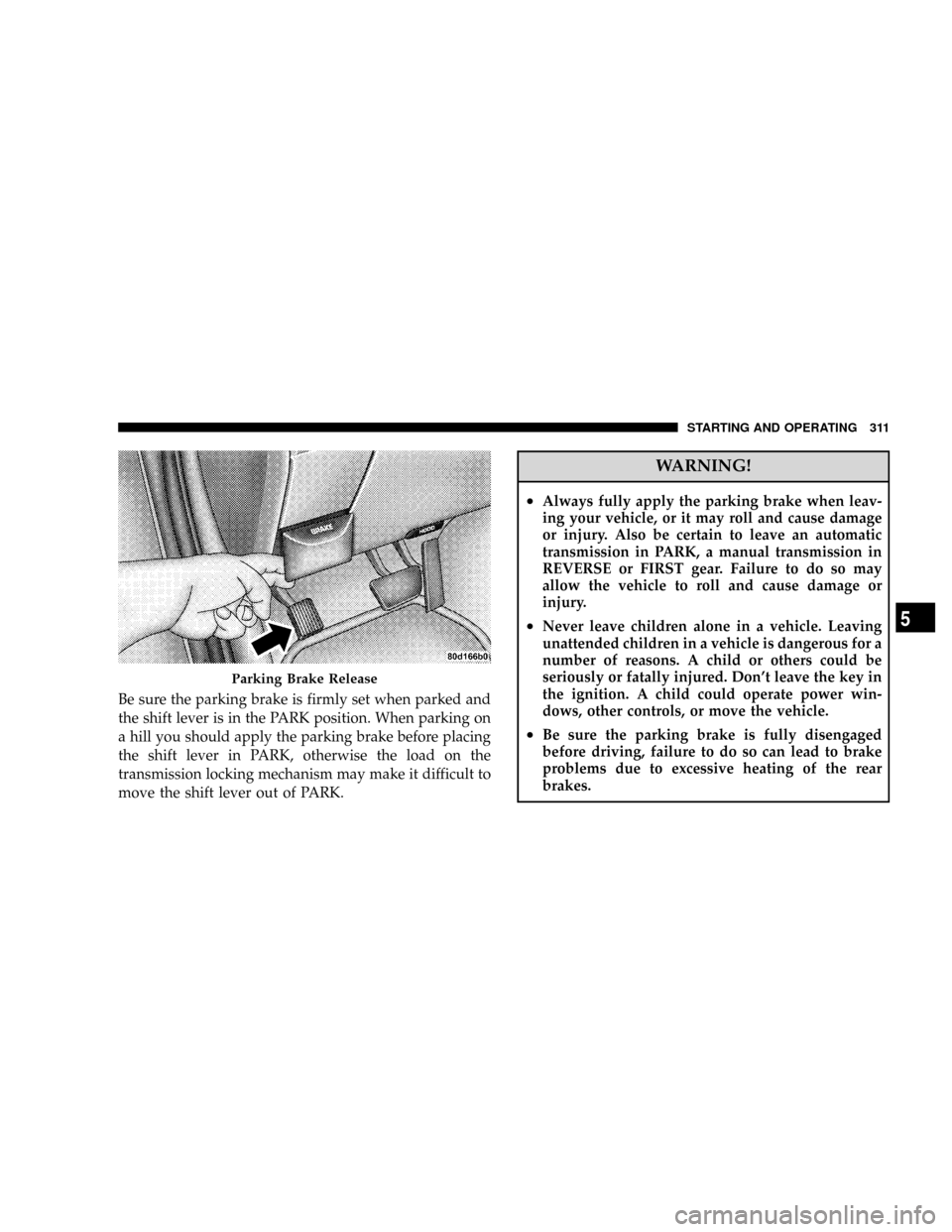
Be sure the parking brake is firmly set when parked and
the shift lever is in the PARK position. When parking on
a hill you should apply the parking brake before placing
the shift lever in PARK, otherwise the load on the
transmission locking mechanism may make it difficult to
move the shift lever out of PARK.
WARNING!
²Always fully apply the parking brake when leav-
ing your vehicle, or it may roll and cause damage
or injury. Also be certain to leave an automatic
transmission in PARK, a manual transmission in
REVERSE or FIRST gear. Failure to do so may
allow the vehicle to roll and cause damage or
injury.
²Never leave children alone in a vehicle. Leaving
unattended children in a vehicle is dangerous for a
number of reasons. A child or others could be
seriously or fatally injured. Don't leave the key in
the ignition. A child could operate power win-
dows, other controls, or move the vehicle.
²Be sure the parking brake is fully disengaged
before driving, failure to do so can lead to brake
problems due to excessive heating of the rear
brakes.
Parking Brake Release
STARTING AND OPERATING 311
5